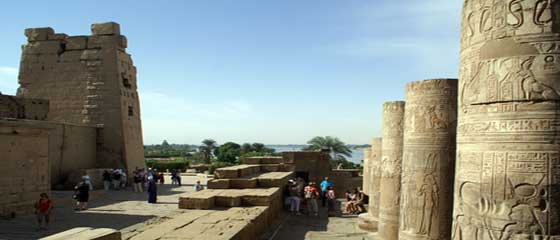
Kom Ombo Temple
© Shanin | Dreamstime.com
Kom Ombo Temple
This page contains information on the history of Kom Ombo Temple, Admission and Opening Times and How to get to Kom Ombo
Background
Kom Ombo Temple stands just a short distance away from the modern day town of Kom Ombo, on the east bank of River Nile 45km north of Aswan and some 60Km south of Edfu.
The temple complex was built over a period spanning more than 400 years first started by the Ptolemies in the 2nd century BC and finally completed by the Romans in 218AD.
What makes Kom Ombo Temple different to many of Egypt’s other ancient temples, is that Kom Ombo was dedicated to more than one deity. The eastern side of the temple is dedicated to Sobek (the crocodile god), presumably due to the hundreds of crocodiles that used to bath on the river banks near by.
In contrast, the western side of the temple is dedicated to the god Horus. Horus was known as a healer, and the entire site was once the final destination of numerous pilgrims who came to Horus in search of help for themselves or their loved ones.
Sadly, flooding has washed away much of the pylon and forecourt, and what wasn’t swept away by the Nile was buried for eons beneath silt and sand. Those parts protruding through the sands were excavated by late Egyptian looking for building materials.
That’s not to say however that the site is to be avoided. The roofless edifice that remains is still hugely impressive in its totally symmetrical design matching ancient reliefs, vestibules, entrances and hallways. The Chapel of Hathor contains three mummified crocodiles discovered in the vicinity.
Admission and Opening Times
Entrance to the site costs 25 Egyptian pounds. The site is open from 6am – 5p in winter and 7am – 4pm during the summer.
How to get to Kom Ombo Temple
The Kom Ombo temple is a standard excursion for visitors travelling between Luxor and Aswan by cruise boat or felucca. This is certainly the most pleasant way to reach the site but don’t expect it to be empty or particularly peaceful unless you arrive early in the morning.
Ferry and felucca trips going via the site can be pre arranged through reputable tour operators before you travel or be booked locally during you visit.
Minibuses travel in convoy at certain times of the day along with police escorts in both directions between Luxor and Aswan, mimicking the journey and the stop offs of the boats but completing the journey in a single days travel.
The sleeper train between Cairo – Luxor – Aswan also stops at both Kom Ombo and Edfu. There are other local train which also make the same journey but strictly speaking tourists are restricted to only certain departures.




